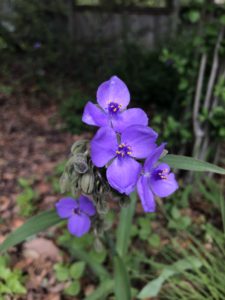
Tradescantia gigantea, also known as giant spiderwort.
During our recent deep freeze and snowfall, most of our native plant species were able to survive, even as many exotic species perished. One early spring bloomer that survived during the freeze was giant spiderwort (Tradescantia gigantea). Even though this perennial plant’s long, slender leaves were already apparent prior to the freeze, they came out nearly unscathed (some leaf tips experienced “freeze burn”).
Now these survivors are displaying their three-petal blooms in pinks, lavenders, purples, and blues, depending soil acidity (acidic yielding blues, and alkaline yielding pinks and purples). Native bees benefit from the nectar the flowers produce. In late spring they yield ¼” seeds which can be easily harvested mid-to-late April for further propagation in any area with full or part shade, and periodic moist soil.
They are often found in small clusters, an ideal way to feature them in a garden setting. As we see more frequent weather extremes in the Central Texas region, consider adding this resilient plant to your native landscape or restoration project.
